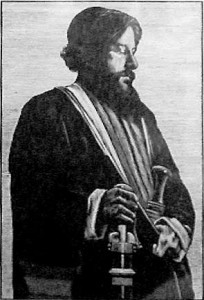Some years ago the Pennyroyal Caxton Bible was published, illustrated by the well-known artist, Barry Moser. I had the privilege of hearing Moser talk about his work some while back and since I am not the most astute observer of art, listening to the artist describe what he did in his various black-and-white drawings opened up whole new vistas of understanding for me.
Moser included two portraits of David. The first shows the young boy David in the Valley of Elah as he prepared to confront Goliath. The boy looks confident to the point of almost being cocky. There is a set to his eyes and to his jaw that signal a burning intensity and the exuberance of youth. Whether Moser intended to convey a kind of swagger I am not sure but “swagger” is the word that comes to mind when I see this version of Jesse’s youngest son. With God at his side, this kid is ready to take on the world (but he’ll start with Goliath for the time being!).

The next portrait fast-forwards a few decades to the David of the Bathsheba period. This time the swagger is gone and so, perhaps, is some of the confidence of youth. The late-middle-age David is someone decked out in enough finery as to let you know he’d achieved all he could have ever hoped for. But the eyes are tired, there is a sort of ennui being depicted, a world-weary “Now that I’ve gotten all I could have wanted what’s left for me?” sort of attitude. It’s the kind of face that reveals the sort of underlying attitude that might just conclude that a pretty younger woman would just be the spark to re-light life’s pilot light after all. This David is no longer ready to take on the world—the world has already taken its toll on him.

The 2 Samuel 5 passage for this Year B Sunday places us somewhere near the midpoint of that trajectory from confident youth to shaky middle-age. Saul is dead. Israel needs a new king, and even if some did not know Samuel had long ago anointed David to take on that very role one day, few if any doubted that David was something more than the logical candidate for the job. As the people tell David, he’d been their de facto king for a very long time now. While Saul battled his personal demons and conjured up spirits with a witch’s help, David fought the real battles with Israel’s enemies and provided the actual leadership for which the people pined.
So since David had been as good as king for years now, it was just a matter of making it official, which they do. David immediately sets up shop by taking the city of Jerusalem away from the folks who seemed to think it was their city. They even taunt David by telling him they could take him down with both hands tied behind their backs and with no one to take him on than the most feeble members of their society.
Well, not quite. David strides right overtop of the people and the next thing you know, other nations are sufficiently in awe of him that they’re shipping him goods and materials with which to build himself a world-class and mighty handsome palace. David was lord of all he surveyed, but one hopes that he himself was as aware of the truth of 2 Samuel 5:10 as was the author of this chapter: viz., that David’s success had one wellspring and one wellspring only: Yahweh God Almighty was with him. The same God who had helped David bring down Goliath was the one behind his every subsequent success, and you just know that if ever David started to let that fact fade into dimness in the back of his mind, things could yet go terribly wrong.
Of course, in terms of the kingdom itself, things went terribly right for the better part of four decades. Eventually David’s own household would crumble into the kind of disarray that could remind one of the Ewing family from the just-resurrected T.V. show Dallas or something. But the political kingdom that David will hand on to Solomon eventually would remain mighty and overall very stable.
In terms of preaching, this text is on the challenging side. It’s mostly an historical hinge point in the wider narrative. There’s nothing particularly inspiring about it per se, unless one can see the bigger picture of God’s faithfulness that undergirds the whole story. Remember: David was the least likely of people to be singled out by Samuel all those years ago. Like any number of other figures from the Bible one could name—Abram, Isaac, Jacob, Joseph, Moses—David was an example of how God raises up the least likely little people to become agents of his renewing grace on the earth.
Here in this chapter David moves into Jerusalem and while the official name of the city did not change on anybody’s atlas, a new nickname was given: “The City of David.” Like New York’s designation as “The Big Apple,” so this “City of David” line would become synonymous with Jerusalem from then on out. And centuries later when a certain no-name, lowly carpenter’s son approached that City of David riding on a too-small donkey’s colt, he would himself be on the cusp of the ultimate raising up of an unlikely person to a position of supreme power and preeminence. The little one who had been born into a feedbunk and who would die on a cross was to become the cosmic King of kings and Lord of lords, the ultimate descendant of David who would sit upon David’s throne forever and ever.
As Moser’s twin portraits of David may remind us, the man David eventually very nearly lost his way and strayed terribly for a time from God’s paths. The world ended up being nearly too much for him. Thanks be to God that when his great-great-great-great . . . grandson showed up, the world would not be too much for him. He’d even manage to save the whole ball of wax!
Illustration Idea
From Eugene Peterson’s Leap Over a Wall (Harper Collins, 1997). Note Peterson’s words on the function of 2 Samuel 5 in the larger narrative of David’s life story:
“Traveling through scenic country, we sometimes come upon a sign reading ‘Roadside Vista Ahead.’ In anticipation we slow down, get out of our car, stretch—and look. We see where we’ve been, we see where we’re headed. Take a breather. Eat a snack. Enjoy the scenery. We can’t always be driving, watching the road closely. Not driving is also part of the trip—savoring what we’ve done, absorbing the landscape, letting the contours of the land and the colors of the horizon sink into our imaginations. These are connective moments. We have various ways of honoring them. We honor them on and with anniversaries, birthdays, graduations, retirements, reunions, celebrations—and by pulling off at roadside vistas. Honoring them is one of the ways we have of keeping our lives coherent—keeping them connected with what we’re becoming. Without frequent reconnaissance, we’re in danger of living in spasms without coordination, without rhythm. The ‘greater and greater’ message of 2 Samuel 5:10 is pivotal in the David story.”
As Peterson goes on to point out, it’s a time to take stock, to anticipate the future, and just so to size up all things under God’s gracious care.
Tags
Sign Up for Our Newsletter!
Insights on preaching and sermon ideas, straight to your inbox. Delivered Weekly!
Sermon Commentary for Sunday, July 5, 2015
2 Samuel 5:1-10 Commentary